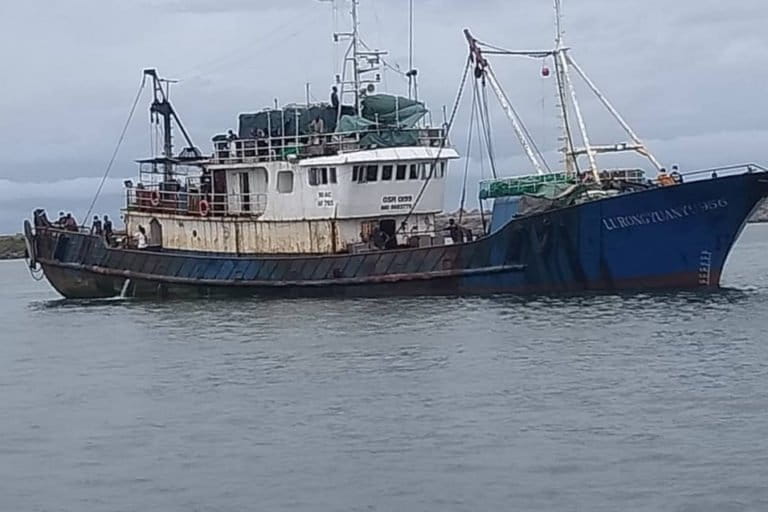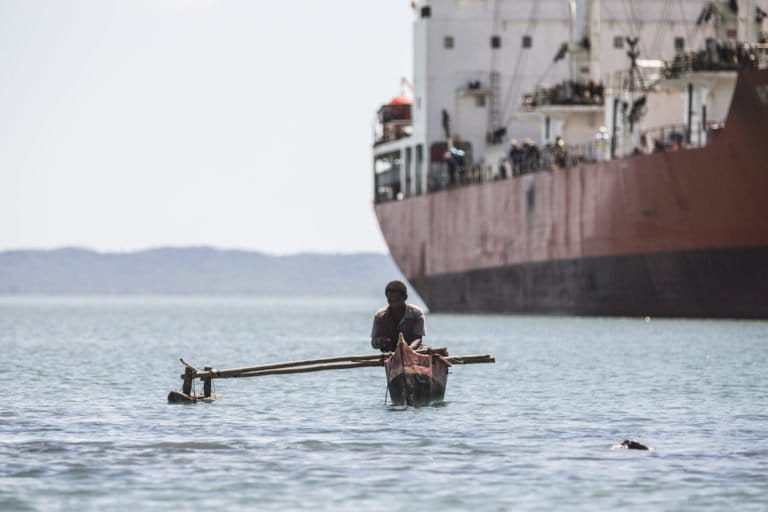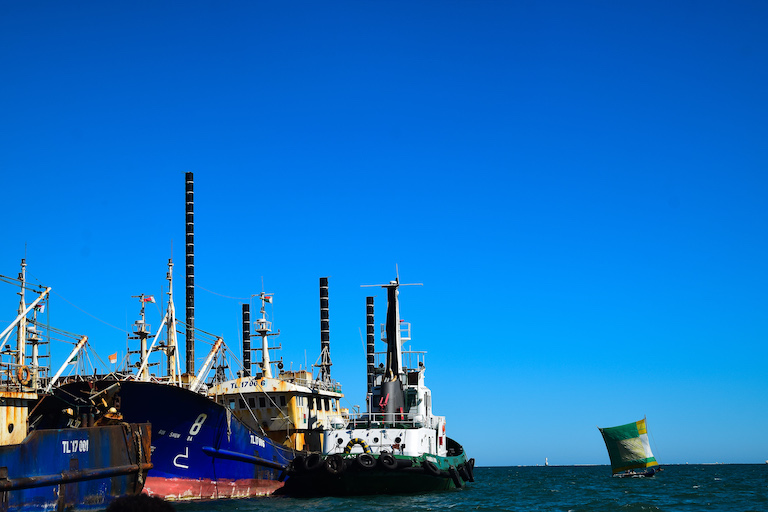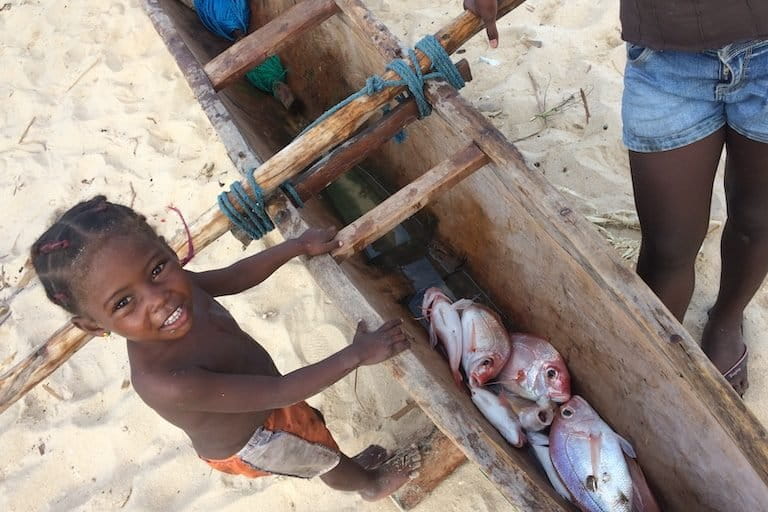- For decades, fleets of industrial vessels from several nations have fished in Madagascar’s waters.
- Now China appears to have joined the fishing spree, sending at least 14 industrial longliner fishing vessels in the last several years, new evidence shows.
- Clues from official documents indicate that Madagascar’s government may have authorized these vessels to fish, at least since 2019.
- If so, the authorization process was not public, raising renewed concerns about the lack of transparency in Madagascar’s offshore fishing sector.
This is part of a three-article series on industrial fishing in Madagascar’s waters. Part one focuses on offshore fishing; part two focuses on a new exclusive-access zone for small-scale fishers; and part three looks at changes in the near-shore trawling sector.
On Madagascar’s east coast, where local people fish in dugout canoes, an onlooker could easily assume there was nothing but traditional fishing all the way across the Indian Ocean. But they would be wrong. Out of sight beyond the horizon, industrial vessels ply Madagascar’s waters, especially during tuna season.
Such fishing has quietly gone on for decades by vessels from several nations, but now there is new entrant whose fleet has a history of engaging in illegal fishing practices: China. In the last several years, at least 14 Chinese industrial vessels have likely fished in Madagascar’s waters, according to a tracking analysis run by OceanMind, a U.K.-based not-for-profit specializing in marine compliance and fisheries management.
Clues from official documents indicate that Madagascar’s government may have authorized these vessels to fish, at least since 2019. If so, the authorization process was not public. Though there is no evidence of corruption, civil society members are on alert due to a series of irregular fisheries deals with Chinese-backed firms in recent years and a longer history of opaque dealing with fleets from other Asian countries and the EU.
 Asian-flagged vessels have dominated in recent years, racking up many tens of thousands of fishing hours per year in Madagascar’s waters, according to a recent academic paper. The scale of industrial fishing activity has raised concerns about the potential for negative impacts on fish populations and marine ecosystems, which support local livelihoods in this extremely biodiverse section of the Indian Ocean.
Asian-flagged vessels have dominated in recent years, racking up many tens of thousands of fishing hours per year in Madagascar’s waters, according to a recent academic paper. The scale of industrial fishing activity has raised concerns about the potential for negative impacts on fish populations and marine ecosystems, which support local livelihoods in this extremely biodiverse section of the Indian Ocean.
Observers have also voiced concern about a staggering lack of transparency. Madagascar’s government doesn’t consult small-scale fishers or local populations before signing deals with foreign countries or companies. In fact, it usually doesn’t make the contracts public or announce when a deal is signed. Conservationists and civil society groups often don’t even know which vessels are there legally, or what they’re permitted to catch.
“It is of course unacceptable that so many vessels operate within Malagasy waters without any publicly known contract or permit,” Ketakandriana Rafitoson, executive director of Transparency International Initiative Madagascar, a civil society group that closely monitors the fisheries sector, told Mongabay after looking at data on the 14 Chinese vessels.
Rising Chinese influence
China’s distant-water fleet — which the IUU Fishing Index platform ranks first among nations for engaging in illegal, unreported and unregulated (IUU) fishing — is the largest in the world. Yet in Madagascar, fleets from Europe and other Asian countries, such as Taiwan, Japan, and South Korea, have historically had a larger presence.
Foreign or foreign-backed fleets have been trawling Madagascar’s inshore waters for shrimp and fish since the late 1960s, and working the offshore waters heavily since the 1980s. Only in recent years have Chinese firms taken significant roles in both of these areas.
Between January 2019 and May 2021, 132 Chinese-flagged vessels operated at slow speeds in Madagascar’s exclusive economic zone (EEZ), which extends 320 kilometers (200 miles) from the coastline, according to tracking data compiled by OceanMind at Mongabay’s request. Of the 132 vessels, 84 had gaps in transmissions of their automatic identification systems (AIS) of at least eight hours while in Madagascar’s waters. This raises the possibility that captains turned off their transponders to avoid being monitored while engaging in illegal fishing. However, there can be legitimate reasons for AIS gaps, and many of these vessels may have been simply passing through the EEZ. (AIS isn’t the official compliance system used by Madagascar and other governments, but its use is required by international law, with some exceptions.)
At least 14 of the Chinese vessels did likely fish in Madagascar’s waters, according to OceanMind’s analysis. After operating at slow speeds in the EEZ, each of the 14 vessels either made port calls or met up with refrigerated carrier vessels in the central Indian Ocean, outside Madagascar’s EEZ, most likely to transfer their catch. (Most of the port calls were in Mauritius, a neighboring island nation.) Many of the 14 vessels have been active in Madagascar’s waters since 2016 or 2017, coming back for multiple tuna-fishing seasons, which run from October to January in that part of the ocean, according to Global Fishing Watch data.

One of the 14 vessels OceanMind found in its analysis was the Lu Rong Yuan Yu 268, a ship owned by subsidiaries of the Jinghai Group, which is itself 40% state-owned, according to information in Triton, a fisheries transparency platform. The vessel featured in a Chinese propaganda film that celebrates the country’s distant-water fleet. A well-known filmmaker directed the film, which aired on China Central TV last year. It showed daily life on board the vessel, which the film proclaimed was on a “magnificent voyage” to the Indian Ocean.
Yet the impact of China’s distant-water fleet is not always magnificent. Three of the 14 vessels working in Madagascar’s waters are owned by Rongcheng Ocean Fishery Co. (ROF), a company based in the city of Rongcheng in northeast China. Another ROF vessel, the Lu Rong Yuan Yu 956, has twice been caught breaking fisheries law in Ghana. In October 2019, Ghana’s government seized the vessel and imposed a $1 million fine for using illegal nets that destroy marine ecosystems and hurt the livelihoods of small-scale fishers. It was Ghana’s first such vessel seizure in five years. The authorities later released the vessel, only to apprehend it again on similar charges in May 2020.
Mongabay reached out to nine Chinese companies that own the 14 vessels, including ROF, four other direct owners and four of their parent companies. None of them responded to Mongabay’s inquiries about the vessels’ legal status in Madagascar waters. Neither did Madagascar’s fisheries ministry, the president’s office, or the Chinese Embassy in Madagascar.
Like ROF, the other companies are registered in or near Rongcheng, a peninsular city with a major offshore fisheries industry. Vessels from Rongcheng have operated in the EEZs of 10 different countries and export most of their product to the EU, according to a Chinese customs document.
The 14 vessels may have received authorization to fish, Madagascar government documents indicate. The country’s most recent report to the Indian Ocean Tuna Commission (IOTC), the intergovernmental body that manages the region’s tuna fisheries, shows that 22 China-flagged vessels worked in the Madagascar EEZ in 2019 — although it’s not clear whether the 14 vessels are among them, as the report doesn’t contain such details. Also, a 2020 tuna strategy document from the fisheries ministry, obtained by Mongabay but not yet public, lists eight foreign companies or associations with which recent deals have been made; most are Spanish, Japanese, or Mauritian, but one is called Junlong, the name of a district in Rongcheng.

Still dealing with Europeans?
When it comes to Madagascar’s fisheries, Europeans are not just consumers at the end of the supply chain. A sizable number of EU-flagged vessels have plied Malagasy waters since the 1980s — or did, until 2018, when the most recent fisheries deal expired. Negotiations have been ongoing since then, but Madagascar and the EU have failed to reach a new fisheries agreement, raising speculation that perhaps the government is pivoting toward Asia and away from what little transparency existed in the sector.
The EU and Madagascar signed a series of multiyear agreements that ran from 1986 until 2018. The deals allowed dozens of European-flagged using longline gear and purse seine nets to work in Madagascar’s EEZ. In the most recent deal, the EU paid Madagascar about $7 million directly over four years, and EU ship owners paid additional fees and advances.
The purse seiners operate in the Mozambique Channel to Madagascar’s west between March and June. They use massive nets and drop fish aggregating devices that allow them to collect large numbers of skipjack (Katsuwonus pelamis) and yellowfin tuna (Thunnus albacares). These tuna are generally young and small, and their meat is canned, some of it at a French-owned cannery in Antsiranana (previously known as Diego-Suarez) on Madagascar’s northern tip. Almost all of the canned tuna is sent to European markets for sale. Thanks to a 2009 free trade agreement, European firms can import canned tuna from Madagascar to the EU without paying a tariff.
In the past, researchers criticized the EU for its lack of transparency during the negotiating process, pointing out that Madagascar had limited power in the negotiations due to its position as a recipient of EU aid. It’s unclear if these power dynamics have changed. Although Malagasy officials invited an observer from the NGO WWF to the initial negotiations in 2018, they did not invite any observers to attend the EU-Madagascar negotiations since then. In a recent email, a member of the EU delegation told Mongabay that the negotiations were ongoing but declined to provide details, citing the need for confidentiality.
Though it’s been the subject of criticism, the EU does operate with a modicum of transparency and some sustainability standards. It publishes fisheries agreements once they are signed, unlike Asian fleets operating in Madagascar or the Madagascar government itself. And its recent overseas agreements have included conservation stipulations, such as reducing the use of fish aggregating devices, which can lead to overfishing, unintended bycatch, and plastic pollution.
Though its deal with the EU has expired, Madagascar may still be doing business with European fleets. EU-flagged vessels can’t be seen operating much in the Madagascar EEZ in OceanMind’s tracking analysis, but do appear at ports in Madagascar and elsewhere in the region, where they’re sometimes required to turn their AIS on. In the past, Madagascar has had private and confidential side deals with French and Spanish fishing associations, and it’s possible that such deals are still in effect: deals with three Spanish associations were active through at least 2019.

Asian fleets in the majority
To the extent that conservationists and civil society groups have tracked offshore industrial fishing in Madagascar, they have mostly focused on European fishing — this is where campaigners say they felt their advocacy could be most effective. However, Asian fleets have long dominated the sector, scooping up roughly 60% of the industrial tuna catch in the past decade compared to roughly 40% by European fleets, according to Madagascar government data.
From 2012 to 2020, Taiwan-flagged vessels alone accounted for about 40% of all industrial fishing effort in the EEZ, according to a recent paper, not yet peer-reviewed, by Easton White, a quantitative ecologist at the University of New Hampshire. OceanMind’s analysis found 90 Taiwanese fishing vessels had operated at slow speeds in Madagascar’s EEZ between 2019 and 2021, 68 of them having eight-hour gaps in their AIS transmissions.
It’s difficult to determine which countries are having the largest impact on Madagascar’s marine life, as companies sometimes use different flags on different vessels. For example, Dae Young Fisheries, a South Korea-based company, has used vessels flagged to multiple Asian countries, including Taiwan, on its vessels operating in Madagascar’s waters in recent years. The company, which has had deals with Madagascar since at least 2011, operated 75 vessels in the EEZ in 2016, but that number has since declined significantly, government documents indicate.
There were six deals with unspecified foreign tuna-fishing entities in effect in 2020; together, they allowed 72 foreign-flagged vessels into the EEZ, according to the tuna strategy document. Those figures represent a decline from previous years, when more foreign vessels were licensed to fish tuna. In 2018, when the EU deal was still in effect and 182 tuna vessels were licensed, the government received roughly $3.6 million in royalties, but in 2020 it received only about $1.4 million, according to the strategy document.
Most of that income seems to come from deals with Asian fleets, which are not closely monitored. Fifty Asian-flagged vessels were licensed to work in the EEZ in 2019, according to the IOTC report. These included the 22 flagged to China and 24 to Taiwan. None of the 50 were observed by fisheries monitors. The lack of observation means that Asian catch in Madagascar’s waters may be even higher than official data indicate. Madagascar’s government relies primarily on self-reporting from vessel staff members. The bycatch could be high as well. Most Asian vessels operating in Madagascar’s waters — including all 14 of the Chinese vessels featured in this article — are longliners that drop thousands of hooks at a time and are notorious for unintentionally killing sea turtles and seabirds.
The upshot is that valuable resources are being removed from regional waters with little transparency and unknown benefits to the Malagasy people, civil society members say. The Asian longliners operating in the EEZ don’t come to port in Madagascar and they don’t generally employ Malagasy staff.
If the Malagasy population as a whole sees little direct benefit from the extraction, coastal villagers who fish for tuna may be directly harmed by it. Tuna and related species account for almost a quarter of small-scale catch in Madagascar, according to government data. Certain Malagasy villages, such as Sainte Luce on the southern coast, are well known for tuna fishing. In season, fishermen use outrigger pirogues or larger artisanal boats to pursue valuable tuna species that they sell in local markets. The fishers have seen a decline in tuna catch in recent years, though it’s not clear if industrial overfishing is the cause, according to a doctoral thesis by researcher Mialy Andriamahefazafy.

Irregular deals with Chinese interests
In recent years, Chinese investors have targeted Madagascar’s inshore and offshore fisheries. In 2017, six Chinese-owned trawlers began plying the waters off southwestern Madagascar, home to a large concentration of small-scale fishers. Local people, who had not been consulted or informed of a deal with the Chinese, mounted a campaign against the trawling, and the fisheries ministry eventually declared it illegal and seized equipment from the vessels, which later moved to Senegal.
The biggest news came in 2018, when a little-known Malagasy agency signed a $2.7 billion fisheries agreement with Taihe Century (Beijing) Investment Development Co., a Chinese company with no experience in the fishing sector. The deal, the details of which the two sides refused to release publicly, would have brought 330 vessels into Malagasy waters. This led to an uproar against then-president Hery Rajaonarimampianina, who was in the room when the deal was signed. Rajaonarimampianina was soundly defeated in an ensuing election, and the current government seems to have quietly shelved the deal.
However, opaque dealing with Chinese fisheries investors didn’t stop when Andry Rajoelina became president in early 2019. Later that year, the ministry apparently signed two deals with Cote d’Or, a company registered in Madagascar but owned by 10 Chinese investors. The deals together authorized 28 industrial vessels to fish in Madagascar’s waters. The ministry didn’t disclose the agreements; the public learned of them only when an anonymous ministry employee leaked them to the Coalition for Fair Fisheries Arrangements (CFFA), a Brussels-based NGO, in November 2020.
The Cote d’Or deals gave the company license to fish a variety of valuable species, including shrimp and lobster. They have raised conservation concerns because, while they do include measures for inspection, they don’t set quotas on catches or specify gear restrictions, Dresy Lovasoa, senior fisheries officer at WWF Madagascar, told Mongabay.
After CFFA published the deals, three Malagasy civil society groups sent the ministry an open letter voicing concerns. The ministry hasn’t responded publicly.

Transparency within sight
If transparency seems like an abstract goal, a lack of transparency can have very tangible consequences. “The impact is that a decision that’s been taken by the government doesn’t take into account the views of local fishers,” Lovasoa said, pointing out that small-scale fishers haven’t had a seat at the negotiating table.
To improve fisheries governance, civil society groups are calling for Madagascar to join the newly launched Fisheries Transparency Initiative (FiTI), a global partnership of governments, businesses and civil society groups that requires participating countries to follow a set of transparency standards. The Seychelles and Mauritania have taken steps to improve transparency in the sector since they signed on. For example, as part of its FiTI process, the Mauritanian government released the contract for a 25-year deal, signed in 2010, with Poly-HonDone Pelagic Fishery, a subsidiary of a large Chinese conglomerate.
Madagascar has made no such progress yet; it hasn’t made a public commitment or officially entered the FiTI process. But it is in discussions to do so, and some members of civil society are optimistic that improved fisheries governance for Madagascar may be within sight.

Banner image: Artisanal fishermen set off in their dhow from Nosy-be in northwestern Madagascar in April 2015. Image © Pierre Baelen/Greenpeace.
Mongabay collaborated with two organizations while gathering information for this article. OceanMind, the UK-based marine compliance not-for-profit, provided a tracking analysis to determine likely fishing activity in the Madagascar EEZ. C4ADS, a Washington D.C.-based nonprofit that runs the Triton fisheries transparency platform, helped research the ownership structures of the 14 Chinese vessels identified by OceanMind.
Sheryl Lee Tian Tong, a Mongabay staff writer based in Singapore, contributed reporting for this article.
Editor’s note 10/1/21: After the publication of this article, I-Lu Lai, section chief of the Deep Sea Fisheries Division in Taiwan’s Fisheries Agency, wrote to Mongabay, stating that all Taiwanese vessels fishing in Madagascar’s EEZ “have been duly authorized to do so by the competent authorities of both Madagascar and Taiwan.” In follow-up emails, another agency official stated that the number of Taiwanese vessels authorized to work in Madagascar’s waters each year was as follows:
2010: 10 vessels
2011: 8 vessels
2012: 12 vessels
2013: 15 vessels
2014: 37 vessels
2015: 22 vessels
2016: 39 vessels
2017: 41 vessels
2018: 50 vessels
2019: 48 vessels
2020: 39 vessels
2021 (through mid-August): 15 vesselsThe agency official stated that the agency doesn’t have the fisheries agreements between Taiwanese companies and the Madagascar government because companies are not required to submit them to the agency, per Taiwanese regulations.
The section chief, I-Lu Lai, stated that Taiwan takes measures to ensure that its fleet operates legally and reduces bycatch of non-targeted species. The section chief also stated that Taiwanese vessels were not required to use AIS, but were instead obliged to use a different technology called a vessel monitoring system (VMS) that enables the Taiwanese government to track their movements. (VMS data, unlike AIS data, is not publicly available.)
Update 10/1/21: On September 30, Madagascar joined the Fisheries Transparency Initiative (FiTI), becoming the fifth country to do so after Mauritania, Senegal, Seychelles, and Cabo Verde.
Citations:
Andriamahefazafy, M. (2020). The politics of sustaining tuna, fisheries and livelihoods in the Western Indian Ocean (Doctoral dissertation, University of Lausanne, Lausanne, Switzerland). Retrieved from https://serval.unil.ch/en/notice/serval:BIB_7E0D668DF275.
White, E. R., Baker-Médard, M., Vakhitova, V., Farquhar, S., & Ramaharitra, T. T. (2021). Distant water industrial fishing in developing countries: A case study of Madagascar. bioRxiv doi:10.1101/2021.05.13.444019
FEEDBACK: Use this form to send a message to the editor of this post. If you want to post a public comment, you can do that at the bottom of the page.
